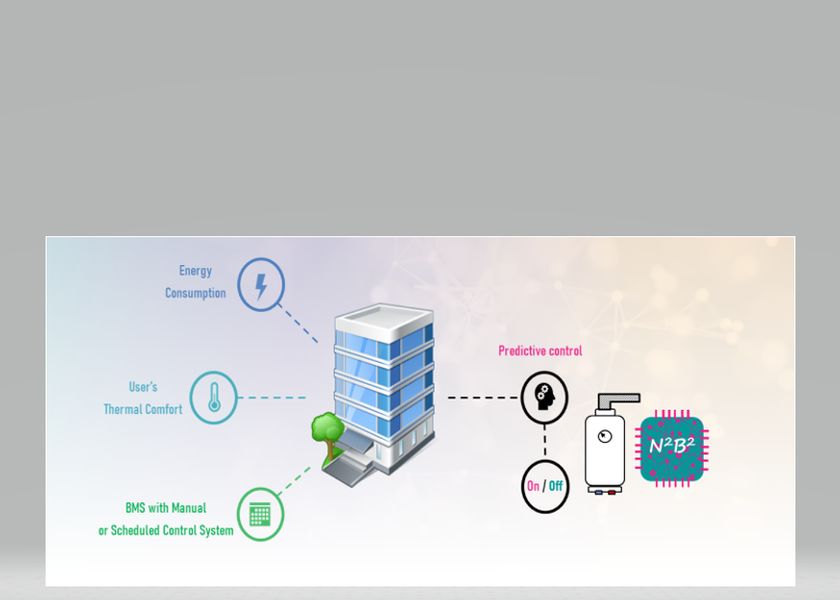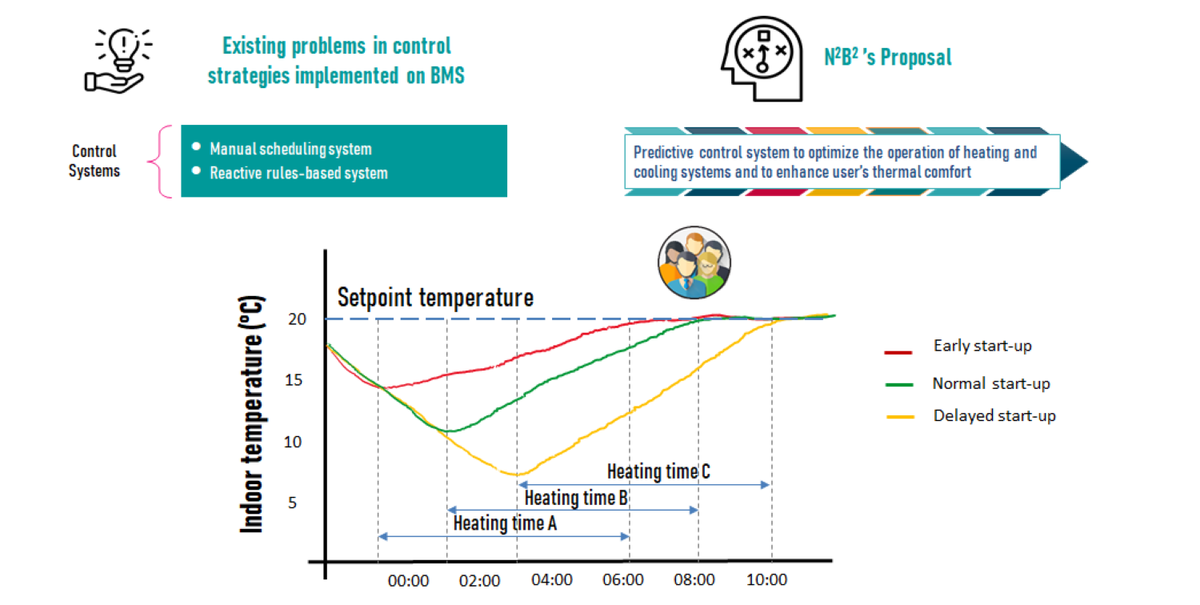N2B2 GRIC UPC: a predictive control algorithm

N2B2 GRIC UPC: a predictive control algorithm
N2B2: a predictive control algorithm implemented on a BMS (Building Management System) in order to optimize the operation of heating and cooling systems, and to enhance user’s thermal comfort.
Smart cities can be defined as scalable solutions that use ICT to enhance the citizens’ quality of life. To facilitate an urban transition, it’s necessary to propose a digitalization paradigm with different strategies: new business models based on smart block chain contracts, reliable management systems to provide a greater flexibility and resilience of buildings, smart traffic management systems to reduce congestion, and people-centered systems in urban planning.
Currently, most tertiary buildings with high occupancy (i.e. offices, universities, schools, primary health center, early care centers and commerce, among others) are characterized to use a manual scheduling system or reactive rules-based system. Within this context, two possible scenarios can be given: (i) early start-up of the heating or cooling system, which implies that the system consumes more energy and the operational costs will be greater; (ii) delayed start-up of the heating or cooling system, which implies that users will present complaints and the maintenance staff will not be able to manage everything.
As seen, the energy management of buildings is really complex. Considering that people spend 80-90% of their lives in indoor environments, it is also important to enhance their thermal comfort. In fact, some studies demonstrated that environmental conditions such as temperature and humidity can affect human health, especially to the respiratory and immune systems of vulnerable populations (children and elderly people).
For this reason, the N2B2 project aims to implement a predictive control algorithm on a BMS (Building Management System) to optimize the performance of heating and cooling systems and to enhance indoor thermal comfort (Figure 1), taking information from neural networks and historical data.

Fig.1. Scenarios
In other words, N2B2 allows turning on/off the heating/cooling systems each day at the optimum time, depending on the building features and the surroundings. In this way, machine learning in the construction industry field makes possible sustainable cities and communities.
Who is behind N2B2?
N2B2 was developed by some members of GRIC Research Group from the Department of Project and Construction Engineering of the UPC (Polytechnical University of Catalonia). GRIC is recognized as a consolidated research group by the Catalan Government in 2009-2013, 2014-2016 and 2017-2019 calls. With N2B2, this research group would like to transfer science and technology from the university to the market, to face the challenges of society.
What are the social and environmental impacts of N2B2?
Regarding social and environmental impacts, the researchers can highlight the following ones: (i) incorporation of smart management to optimize the performance of building facilities (heating and cooling systems); (ii) improvement of user’s thermal comfort; (iii) reduction of operational costs; (iv) enhancement of the decision-making by practitioners.
What is the difference with respect to other existing technological solutions?
In recent years, enterprises invested in sensor networks to monitor and control building systems. Nevertheless, up to 90% of gathered data is unused for predicting scenarios. In addition, maintenance staff and building managers consider that existing BMS present several barriers: no integrability with other protocols, large number of restrictions, low scalability and versatility with high prices, and complex configurability by the practitioner among others.
In contrast to other enabling technologies (i.e. Building Information Modeling or Digital Twin models), N2B2 does not require a large quantity of data and computation time. Furthermore, this proposal is totally scalable regardless of building usage, since commercial BMSs have the same patterns of control and the performance of heating/cooling systems is slightly equal in all tertiary buildings. To analyze the reliability of N2B2, several proof-of-concepts were performed in a building of the UPC – Campus Terrassa and several schools of the region.
Your cookie preferences
We use cookies and similar methods to recognize visitors and remember their preferences. To learn more about these methods, including how to disable them, view our cookie policy.


